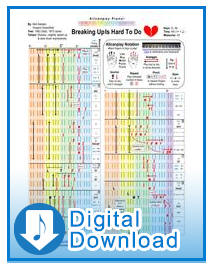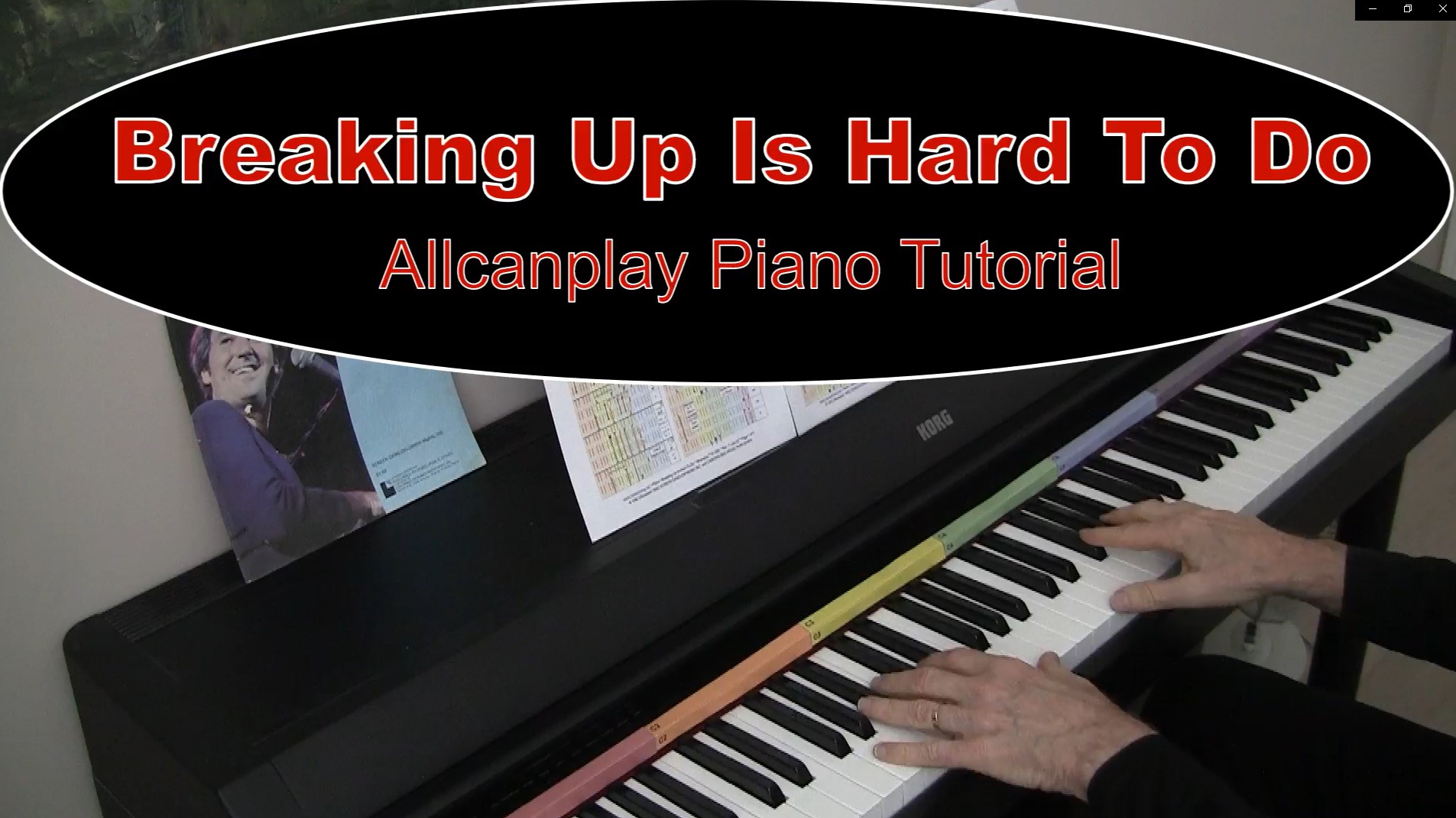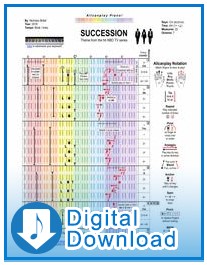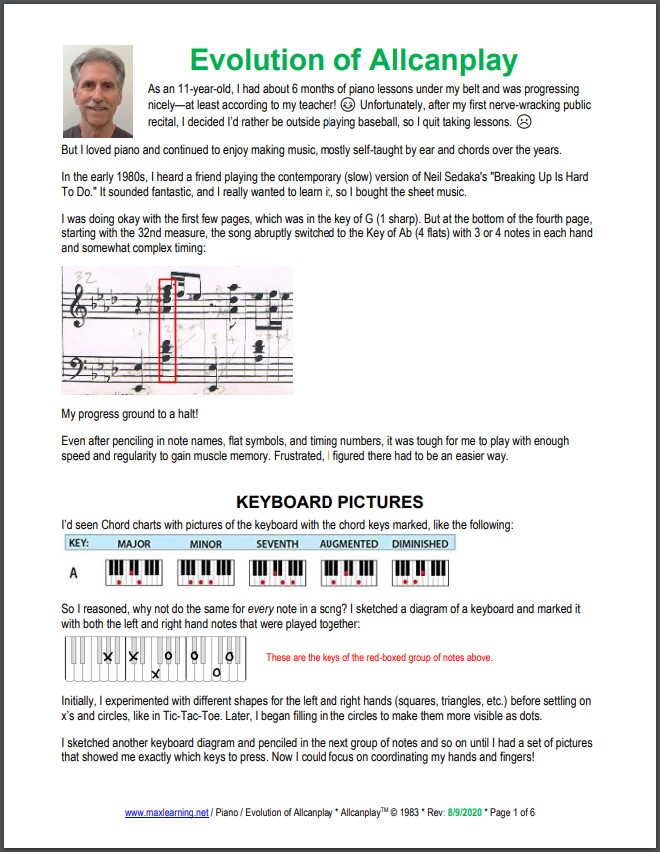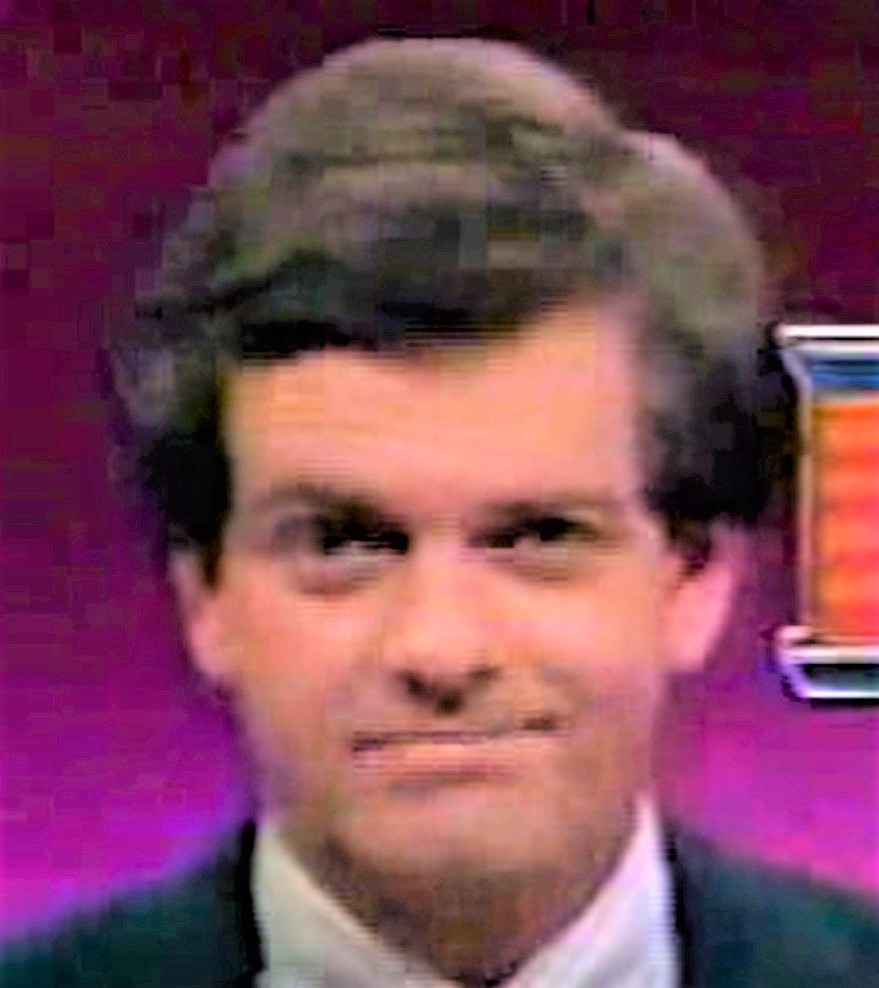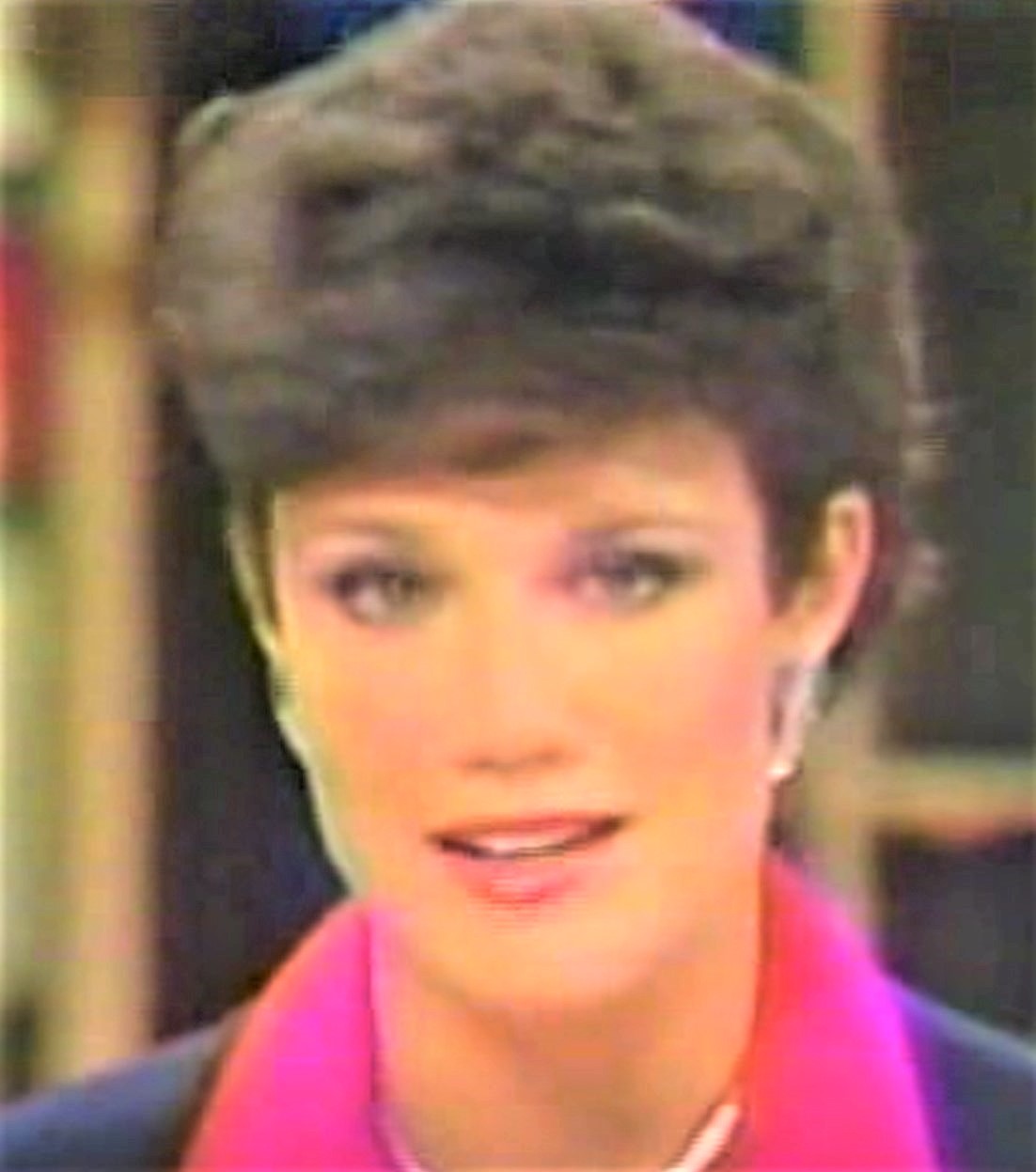|
MaxLearning.Net |
||
|
Home: https://www.maxlearning.net * Email: mike.weinberg1952@gmail.com |
||
|
|
||
| Topic |
Text |
Video |
|
Welcome to Allcanplay! |
 3 pages |
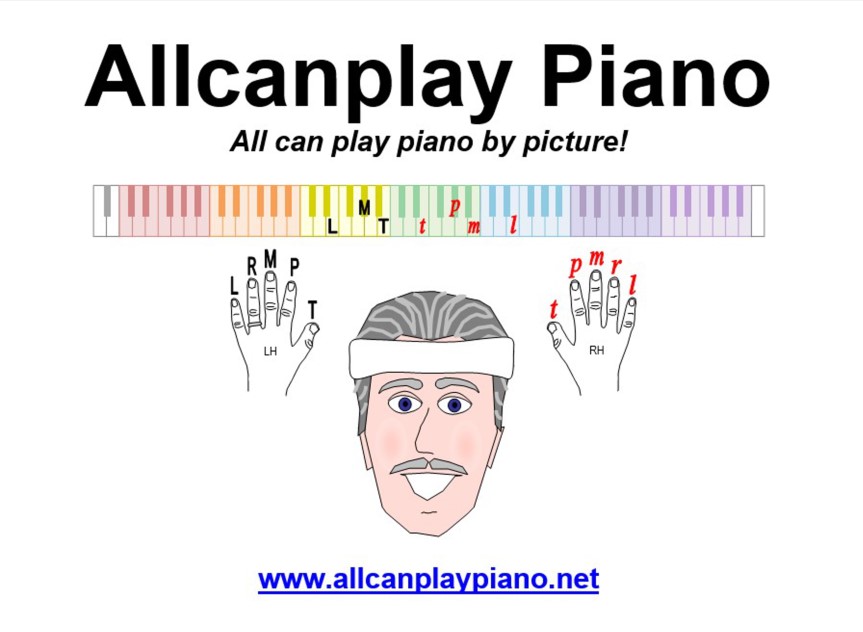 7:42 min |
|
Piano Basics Pros and cons of acoustic vs. digital pianos, how to sit at the piano, hand and fingering tips and traps. |
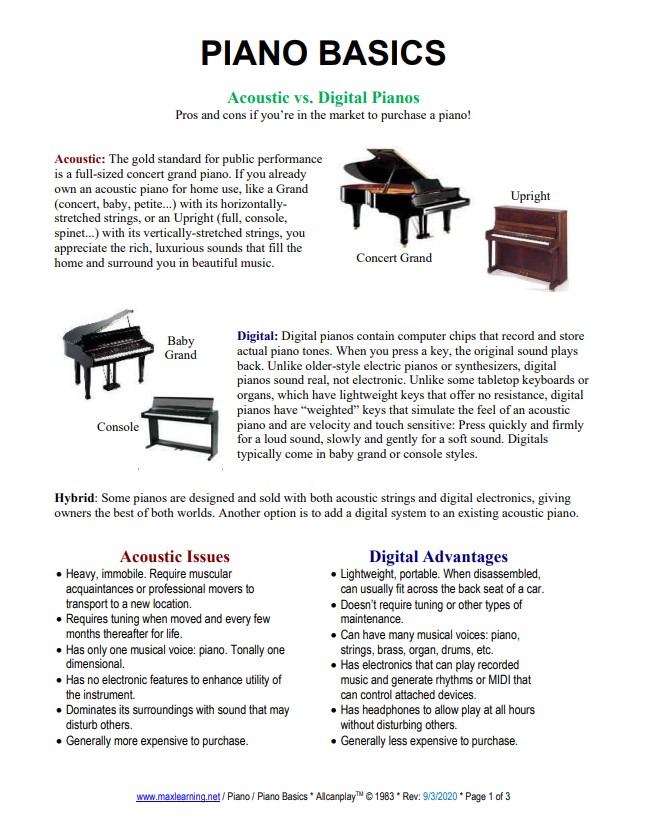 3 pages |
|
|
Keyboard Navigation Importance of black keys, up vs. down, names of keys including sharps and flats, finding Middle C, counting octaves, octave shading. |
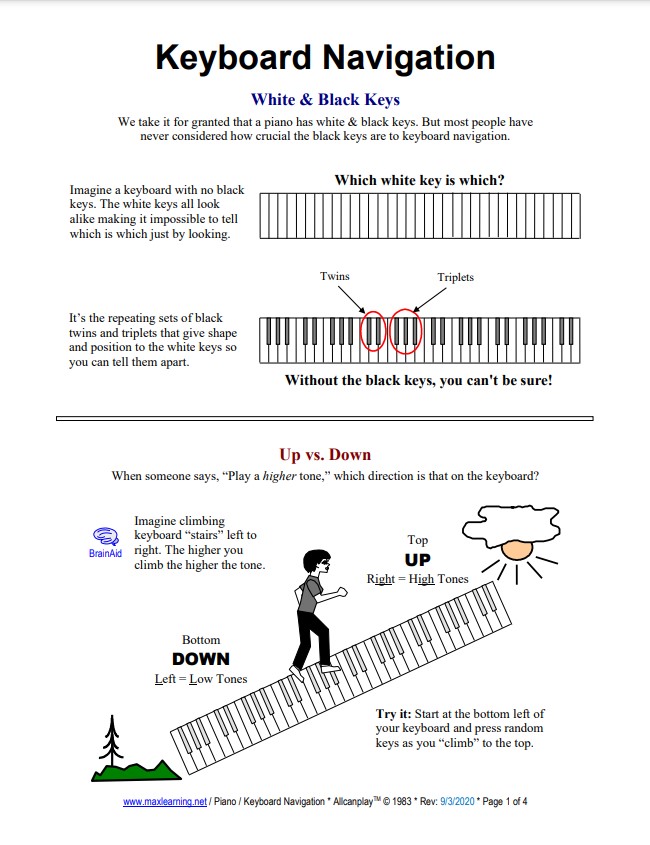 4 pages |
|
|
Rainbow Keyboard Since all octaves look alike, imagining each octave as a rainbow color can help you know where you’re at and make it much less likely you’ll play in the wrong octave. To “rainbowize” your keyboard, print out & attach the colored strips! |
2 pages |
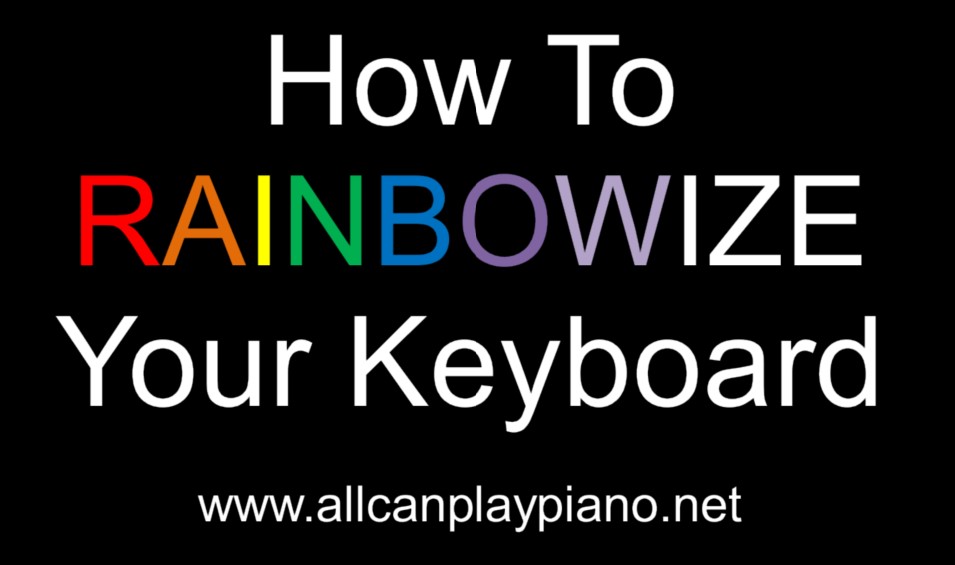 3:30 min |
|
Allcanplay Symbols These special Allcanplay notation symbols will ease and speed your learning: Spans, Pinches, & Ties. Anchors, Parallels, & Backstops. Arpeggios, Pivots, & Crossings. Ghosts & Tips. |
3 pages |
|
|
Warmups Gain flexibility and coordination by playing a variety of basic patterns that you'll encounter in future songs. You'll start by playing individual fingers One Hand at a time then progress to the challenge of playing Both Hands together. Finally, you'll learn to play groups of keys together in Fixed Hand warmups, including keys an octave apart. |
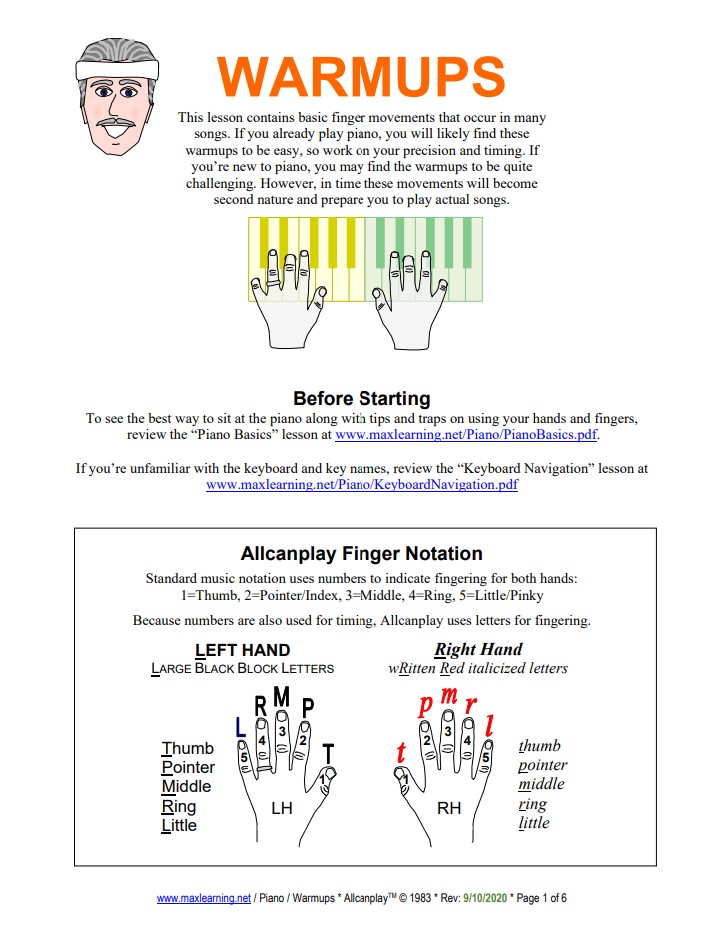 6 pages |
One Hand 3:28 min Both Hands 3:04 min Fixed Hand 5:23 min |
|
ALOUETTE This catchy French-Canadian folk song has both hands in 5-finger position so you never have to move them. Played mostly with the right hand, both hands join in at the end for some "parallel motion." |
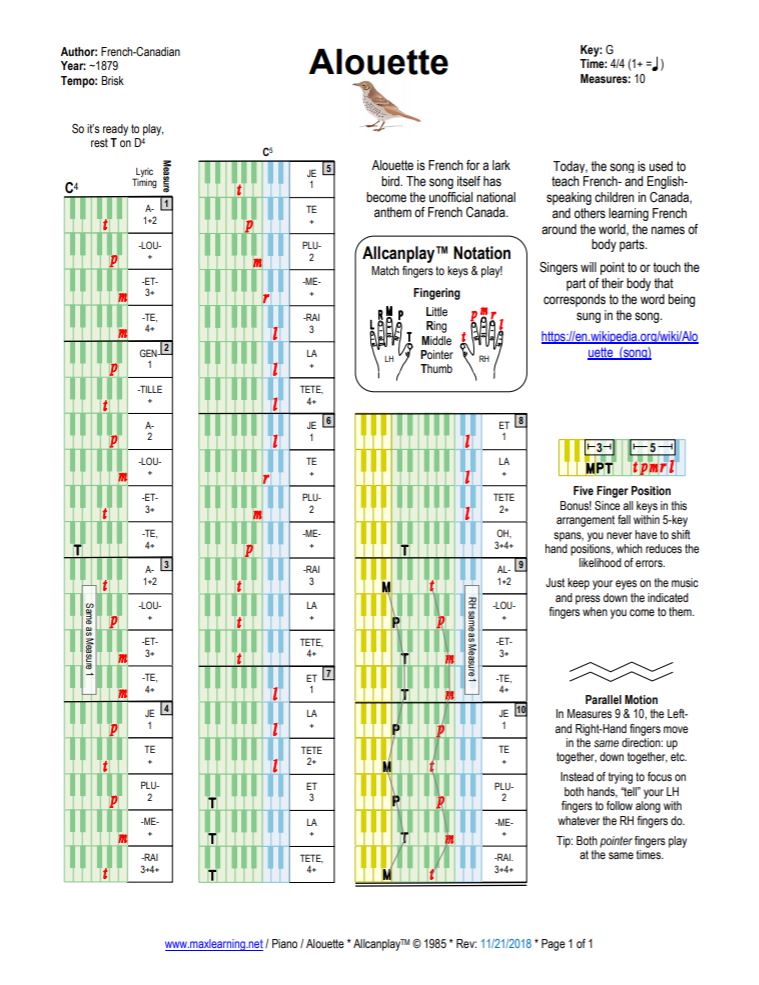 1 page Audio - 27 sec |
 4:58 min |
|
Practice & The Piano Paradox Practice and repetition are necessities, but there are smarter ways to practice that can reduce learning time. Learn about your two types of memory and the Piano Paradox: Slow Practice = Rapid Progress! |
 3 pages |
|
|
WHEN THE SAINTS GO MARCHING IN Originally a slow funeral dirge, "The Saints" was transformed into a lively jazz number. It's said to be the tune most requested of Dixieland bands. 5-finger positioning throughout makes this version a snap to play. |
1 page Audio - 21 sec |
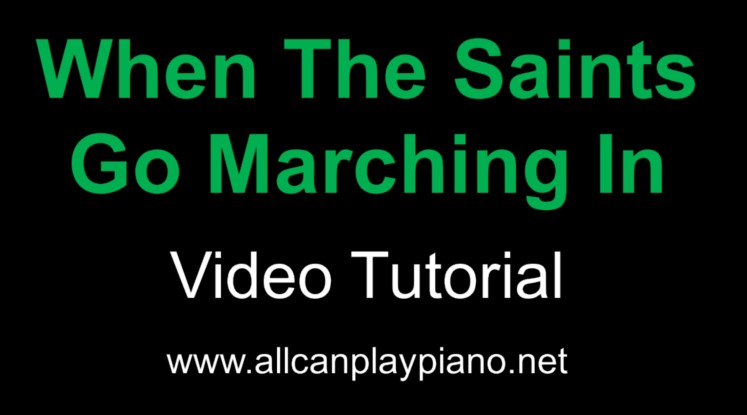 6:58 min |
|
Piano & Math Research shows that piano training enhances math ability. An ideal learning combination would include both math and piano! |
1 page |
|
|
ODE TO JOY This famous song is from Beethoven's 9th Symphony, his last. If you don't know it by name, you'll likely know it when you hear it. A section that repeats 3 times and 5-finger position throughout make for quick learning. |
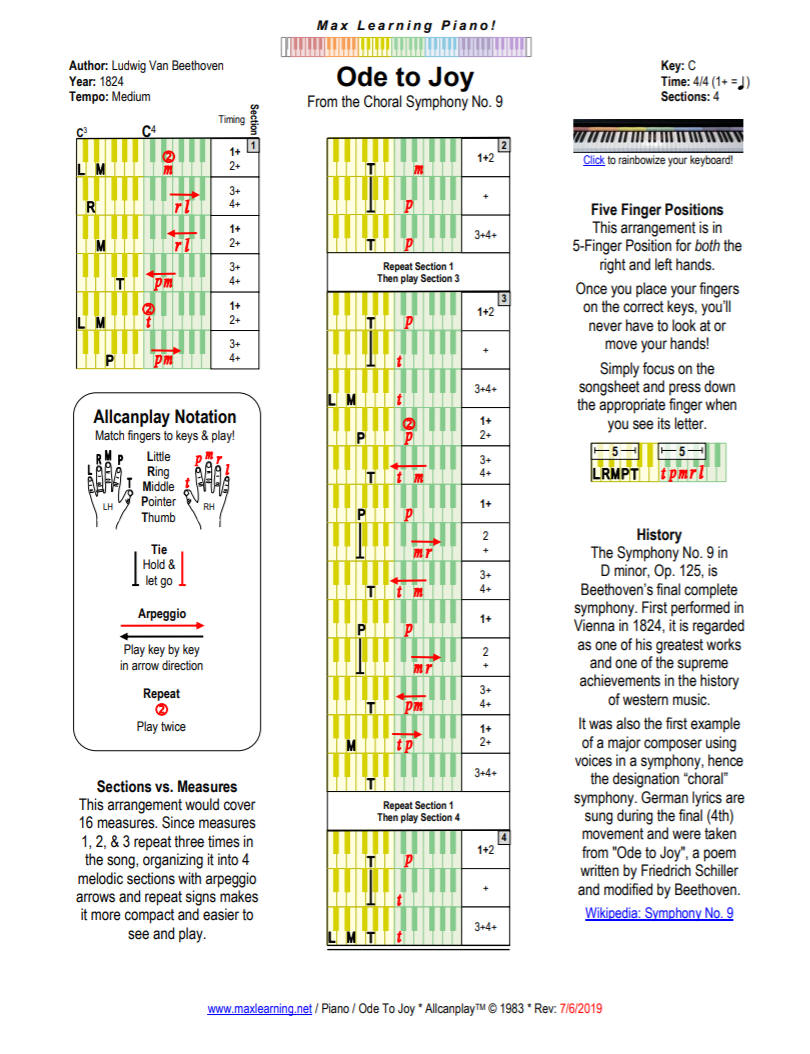 1 page Audio - 33 sec |
 11:39 min |
|
Motivation & Performance Anxiety What is it about music that makes you want to make it yourself? Whom should you play for? Why is it you play a song perfectly when you're alone yet make a mistake as soon as someone walks in the room? How to play more confidently. |
 4 pages |
|
|
Sight Reading The more you learn to play without looking at your hands, the better you can focus on the written music and not lose your place. Techniques include feeling keys, pinching fingers, and reaching intervals. |
 3 pages |
|
|
CHOPSTICKS This lively ditty is typically played by children using both pointer fingers. But as a fun way to practice, you'll play it with alternating hands. |
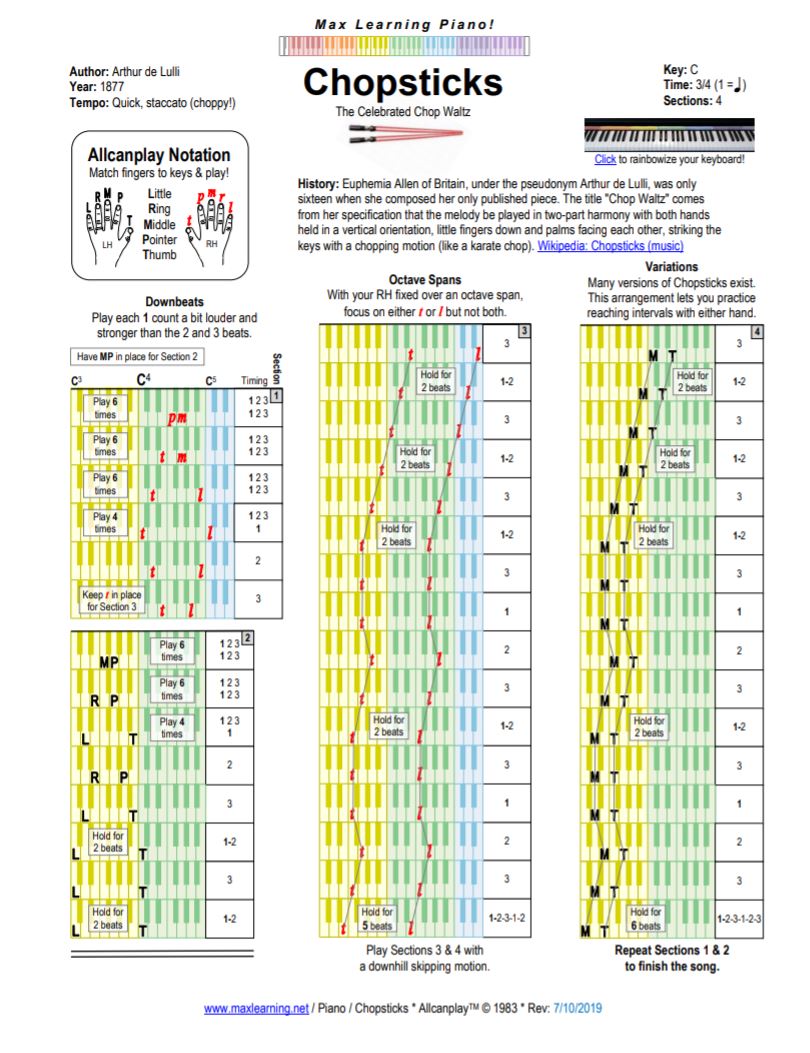 1 page Audio - 36 sec |
|
|
Chords Chords are groups of keys, usually played with the left hand to add harmony to the melody of a song. We'll start with the 12 major chords and ways to play them: blocked, broken, arpeggio, inverted, etc. |
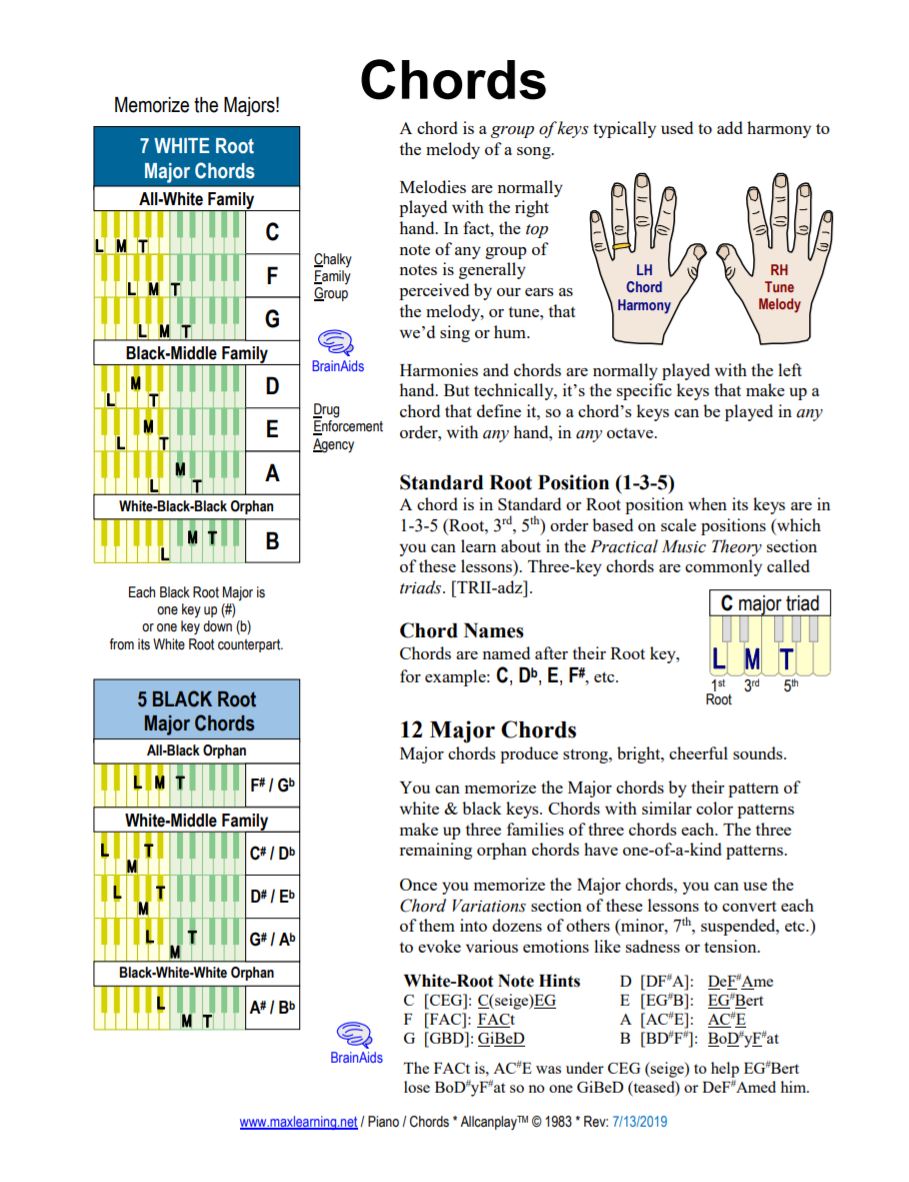 4 pages |
|
|
Chord Variations Using simple rules, each major chord can be converted into dozens of variations (minor, 7th, etc.) that set song moods (sadness, tension, etc.). |
3 pages |
|
|
Chord Constructor Chart Print and laminate (see video below) this chart for use with a dry-erase pen to build dozens of chord types using simple pattern rules. |
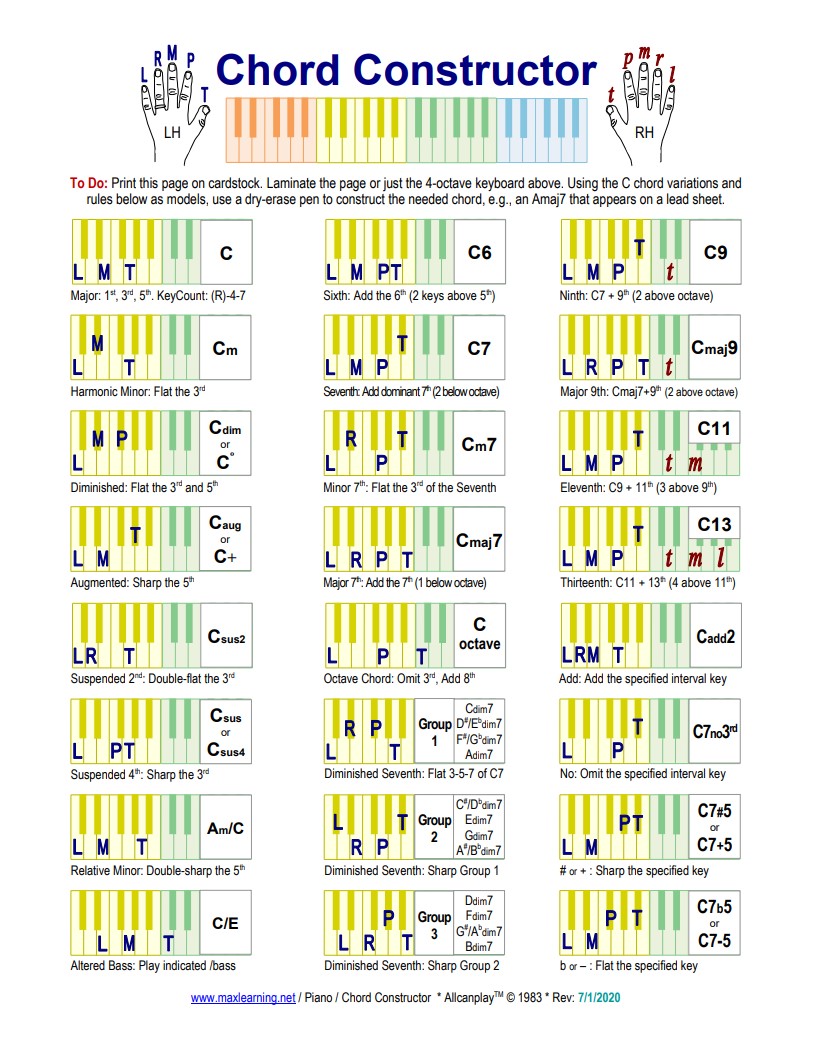 1 page |
|
|
Laminating Your Charts For Chord Constructor, Transposer, and 88 & 5th charts. Supplies needed: lamination sheets, squeegee, scissors, dry-erase pens, cloth eraser. |
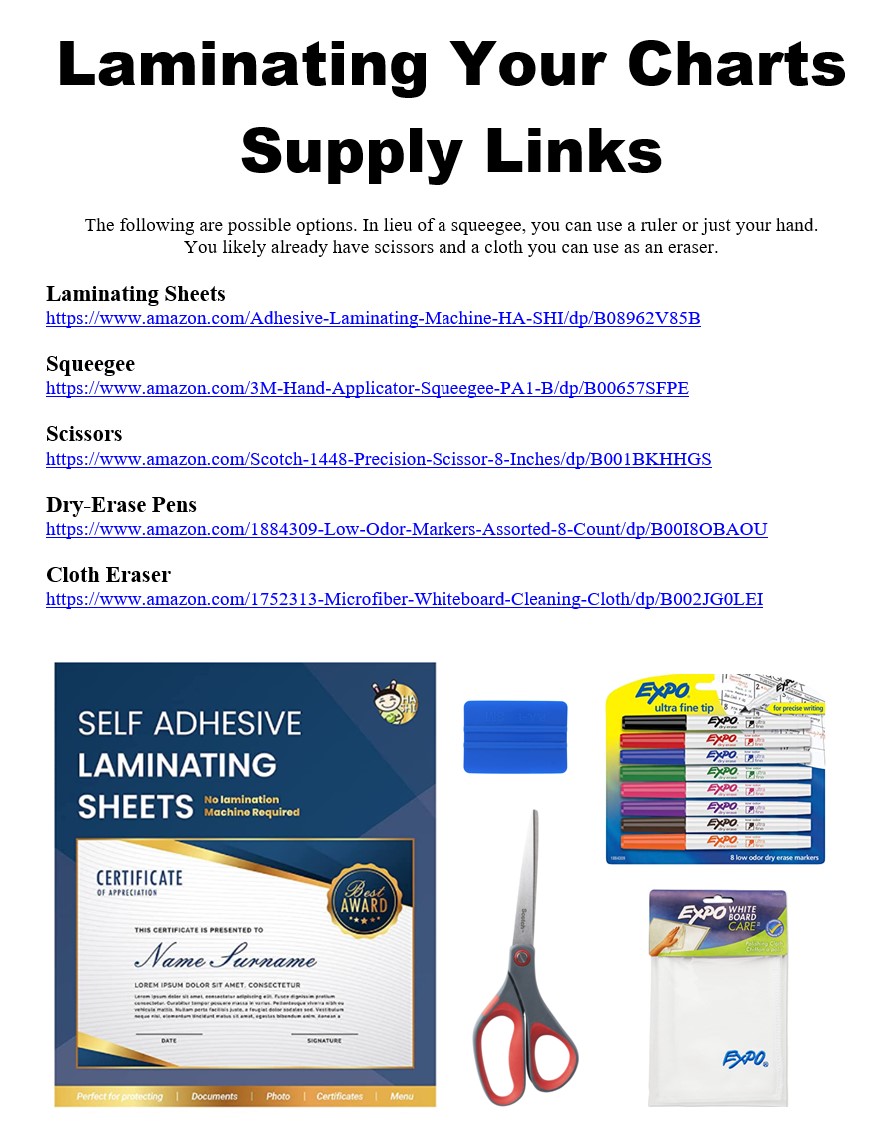 1 page |
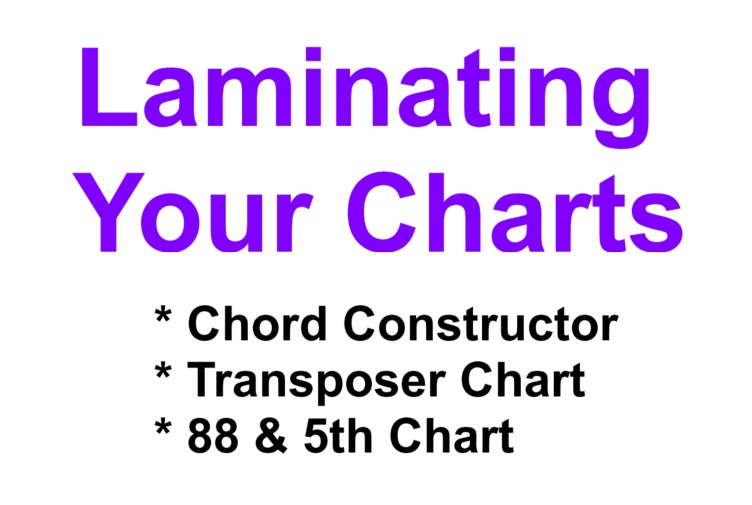 1:45 min |
|
LEFT HAND BOOGIE This dynamic song is played with the left hand repeating a basic 12-bar blues pattern over 3 major chords: C, F, & G. The rhythm is energizing when played in Block style and even livelier with a Grace-note variation. |
1 page Block audio - 13 sec Grace audio - 10 sec |
 9:20 min |
|
Pedaling The sustain pedal smoothes out the gaps in sound that occur when you move your hands from one set of keys to the next. Pedaling adds a professional touch that will set your playing apart. |
3 pages |
|
|
AMERICA THE BEAUTIFUL This well-known anthem has you using and moving both hands, which requires good finger coordination and lots of practice. But its stirring melody and rich chord harmonies are a joy to play and hear. |
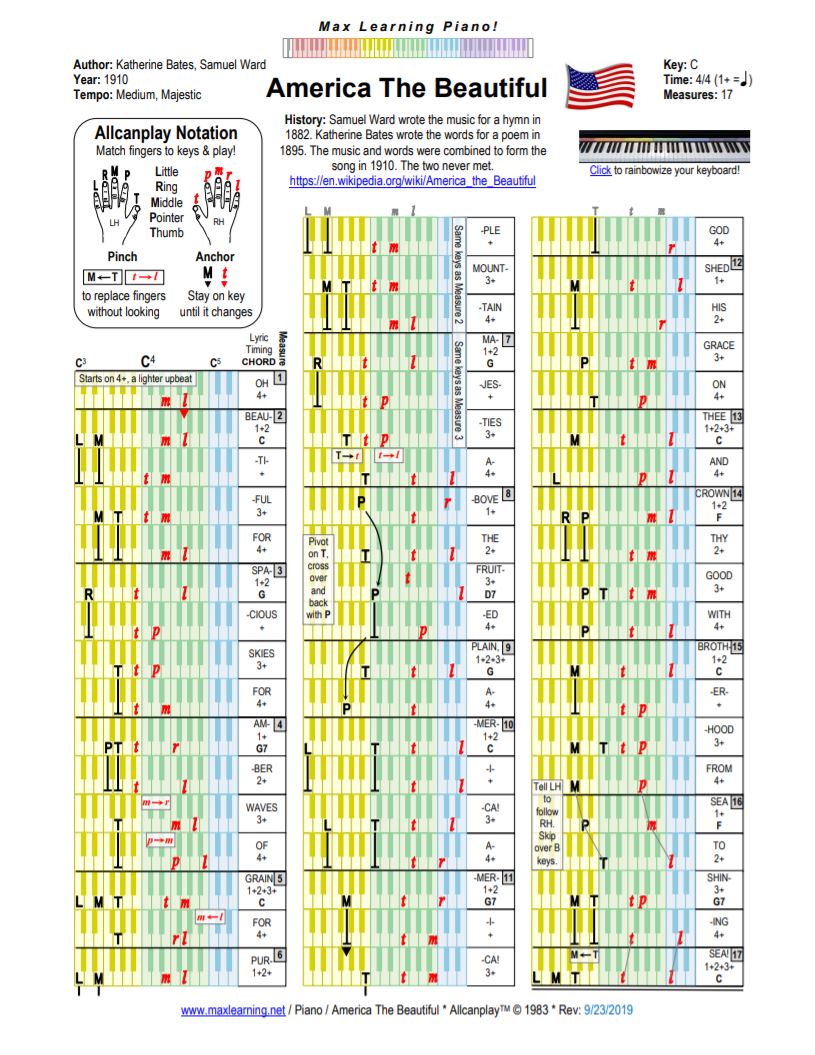 1 page Audio - 47 sec |
|
|
Arpeggios & Climbs A great way to learn chords is to arpeggiate (like a harp) them up and down over several octaves. Crossing hands and "spotting" keys is great fun. Climbing Chords add grandeur and flair. |
 3 pages |
|
|
HAPPY BIRTHDAY SONGSHEET Print this songsheet to use for the following lessons: * Playing By Ear * Fingering |
1 page |
|
|
Playing By Ear Most people assume that playing by ear is an inborn skill. But if you can hear a wrong note in a song, you can play by ear. You'll pick out the Happy Birthday melody with the right hand, then add harmony using chords in the left hand. |
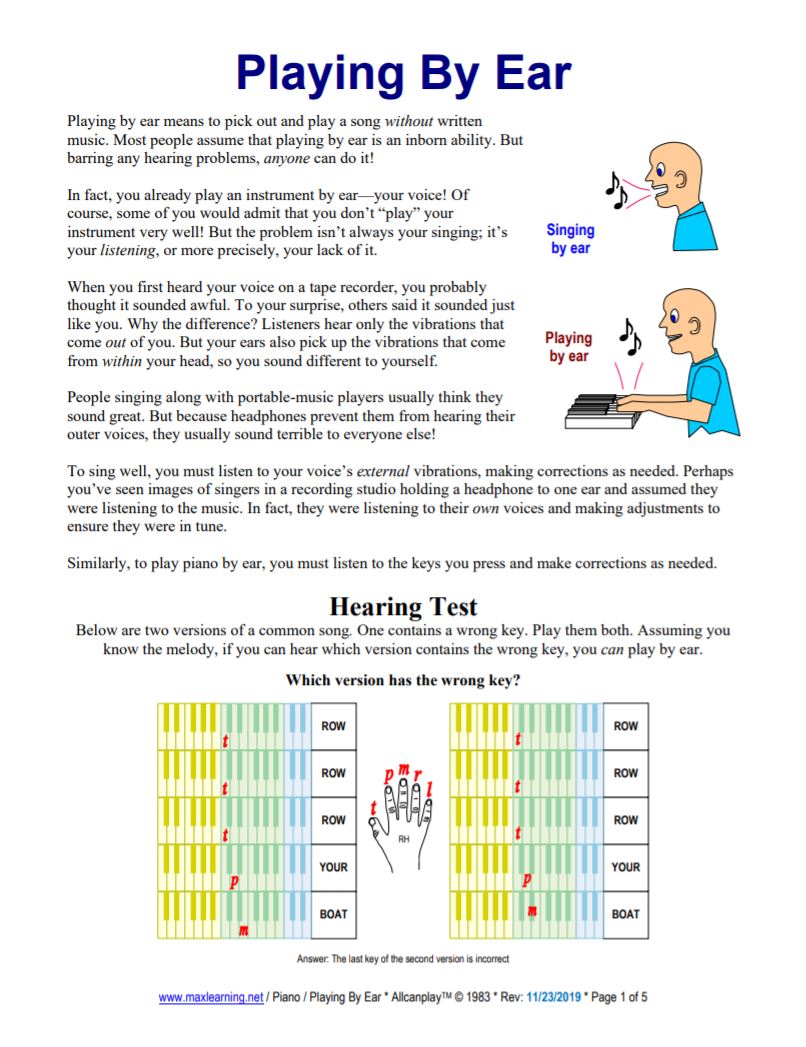 5 pages |
|
|
Fingering Since fingers develop muscle memory, it's important to use the same fingers each time you play a song. You'll learn various techniques then assign fingering to Happy Birthday (which you picked out in the Playing By Ear lesson) as well as one possible chord arrangement. |
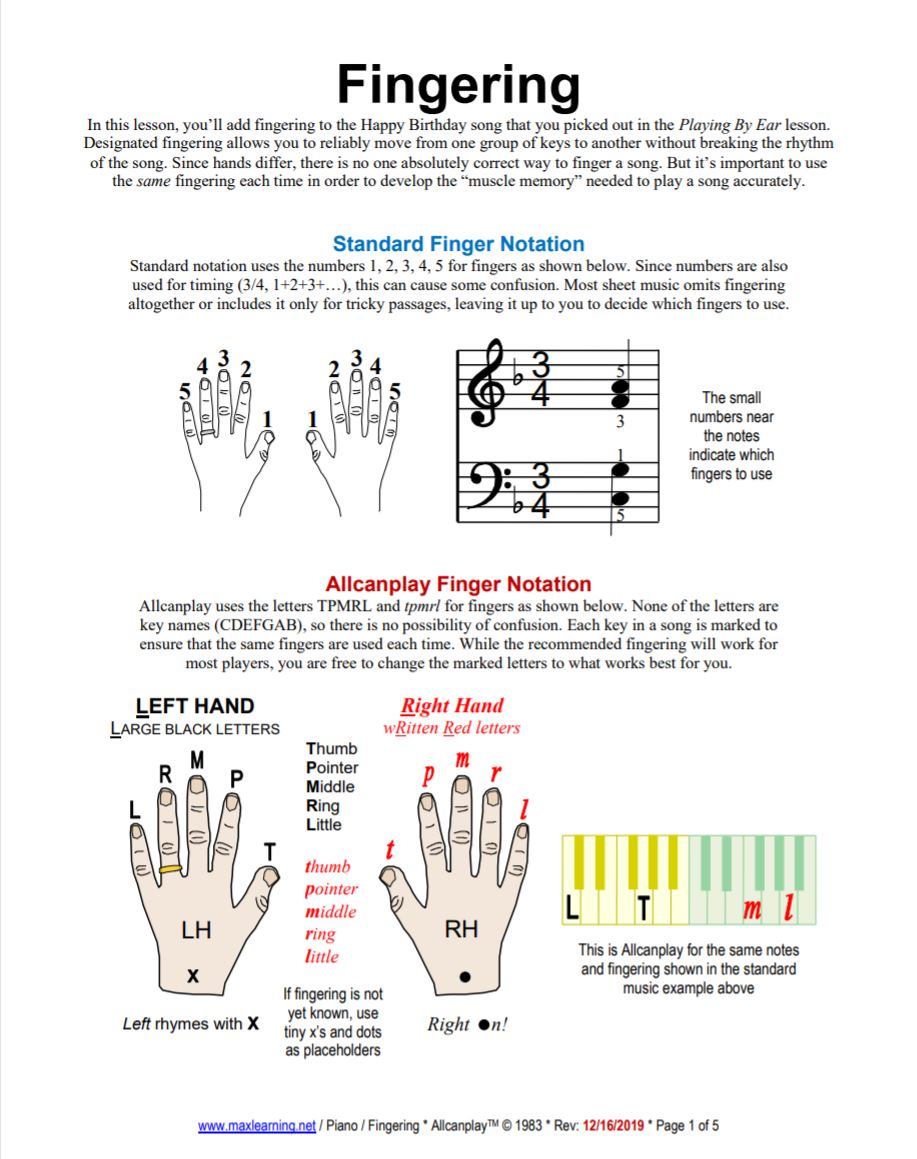 5 pages |
|
|
FÜR ELISE Nearly everyone recognizes this famous Beethoven tune, even if not by name. In this abbreviated version, only one hand plays at a time, yet it sounds deceptively complex. |
1 page Audio - 13 sec |
|
|
Reading Music Standard notation is the universal language of music. Knowing how to read it opens a whole world of songs to you. We'll see why it's such a challenge to learn and explore ways to enhance your reading ability. |
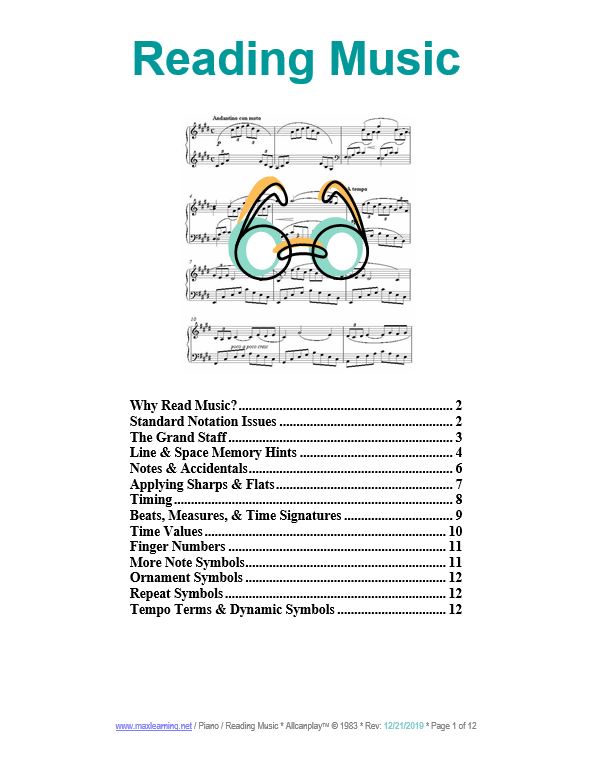 12 pages |
|
|
Converting Songs to Allcanplay If there's a song you're longing to play but the sheet music is beyond your current note-reading ability, use the included guides to convert it to Allcanplay pictures. You'll become a better note reader in the process. |
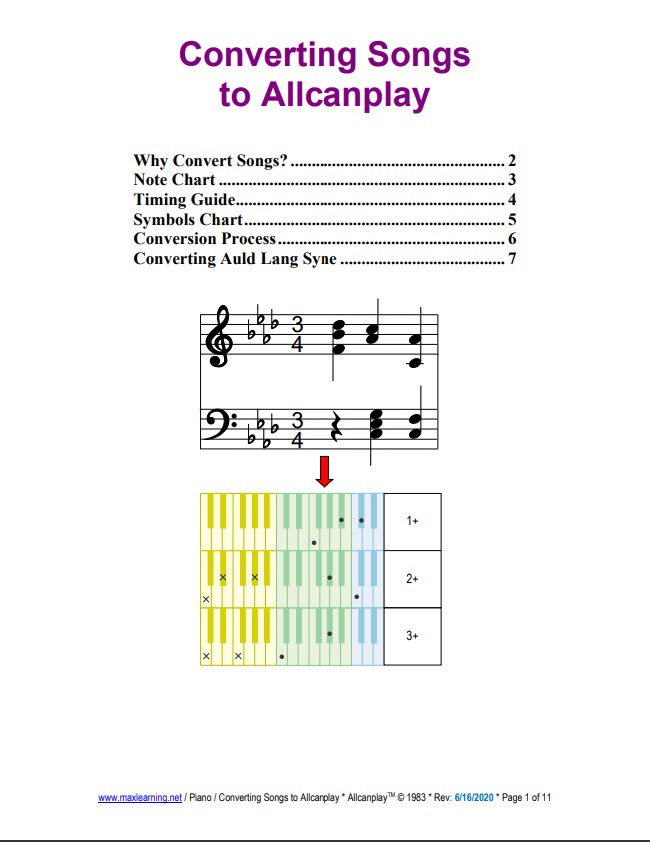 11 pages |
|
|
HEART & SOUL Traditionally played with a partner, this bouncy tune will challenge your left/right-hand coordination and timing. Duet fingering appears on page 2. This is the song that made me want to learn piano when I first heard two classmates play it in grade school! |
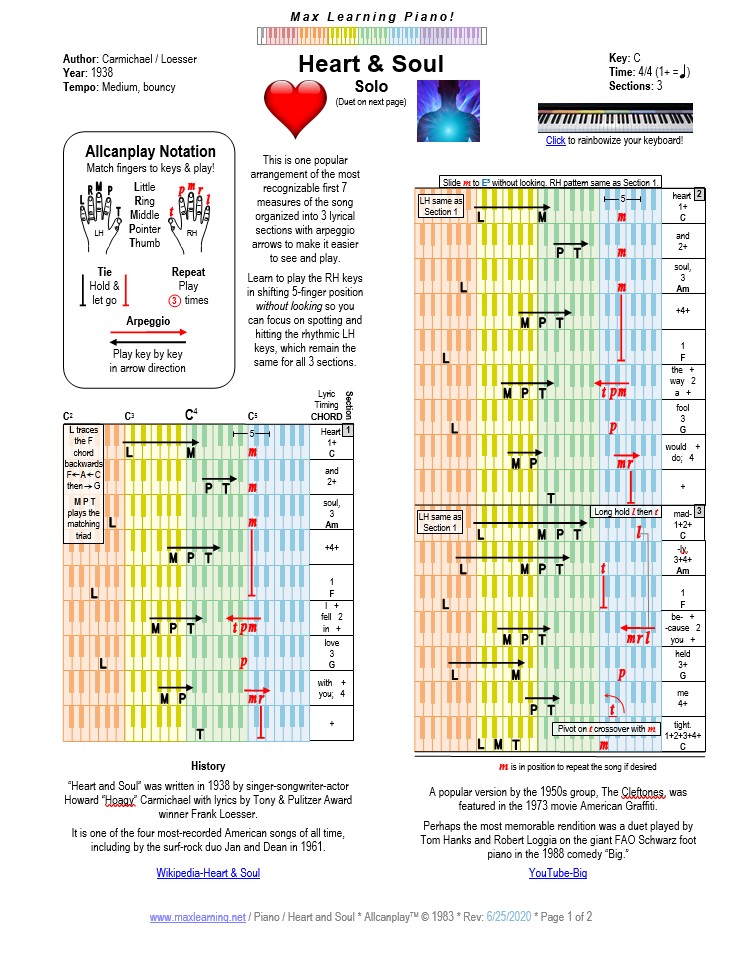 2 pages Audio - 16 sec |
|
|
Practical Music Theory Apply music theory to practical uses. Build scales, intervals, and chords. Find the Key of a song. Develop chord progressions. Apply the features of the Circle of Fifths. |
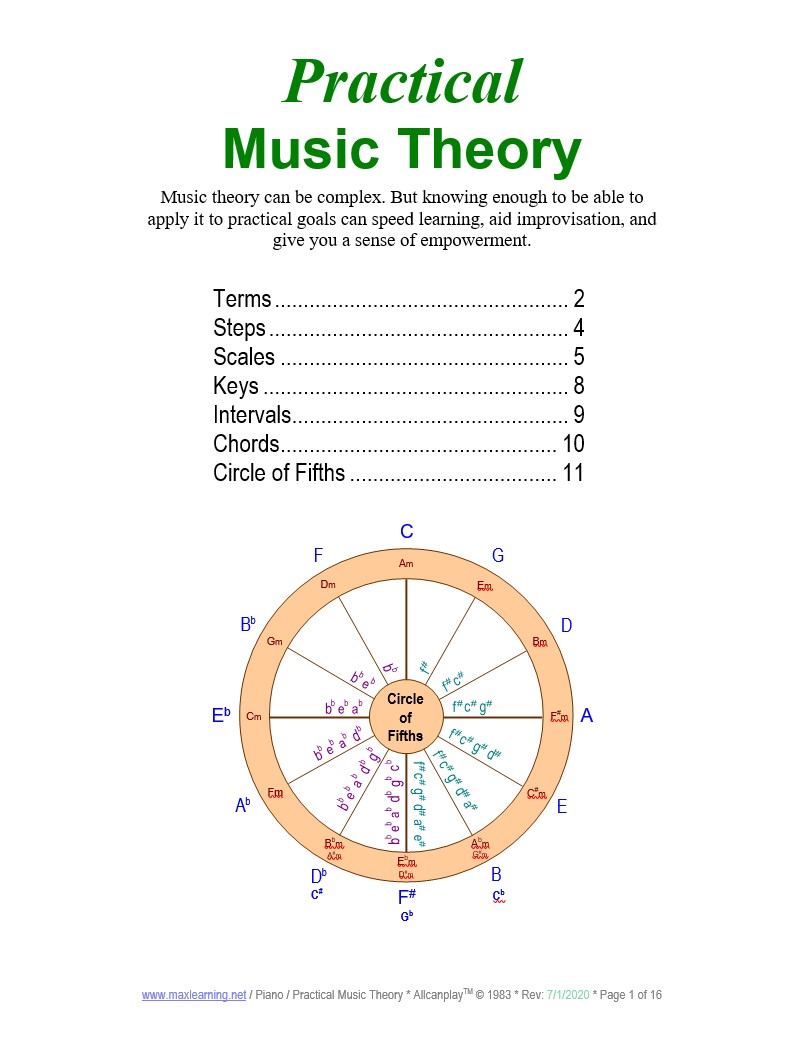 18 pages |
|
|
CANON IN D Pachelbel's Canon is the quintessential "Wedding Song." You'll know it when you hear it. Progressing through 5 chords, it sounds deceptively simple at first but is surprisingly tricky to master. This abbreviated version reveals the essence of this glorious melody. |
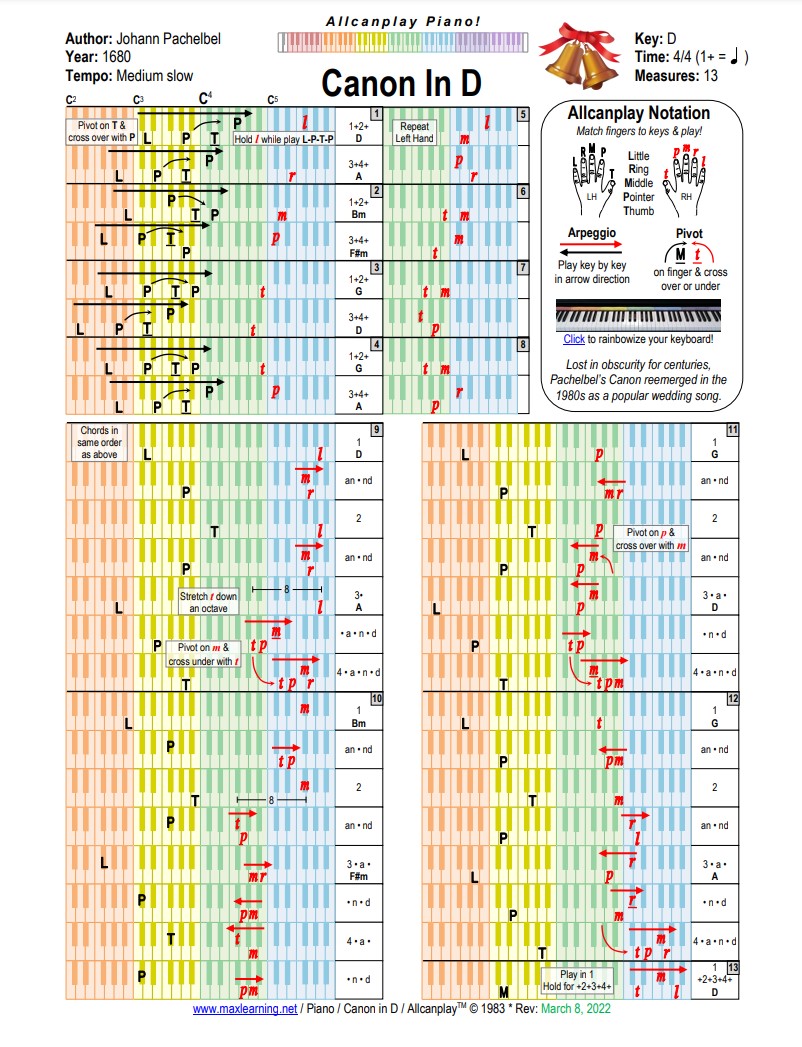 1 page Audio - 49 sec |
|
|
Transposer Chart Print and laminate (see video above) this chart for use with a dry-erase pen to aid in transposing chord progressions and notes. |
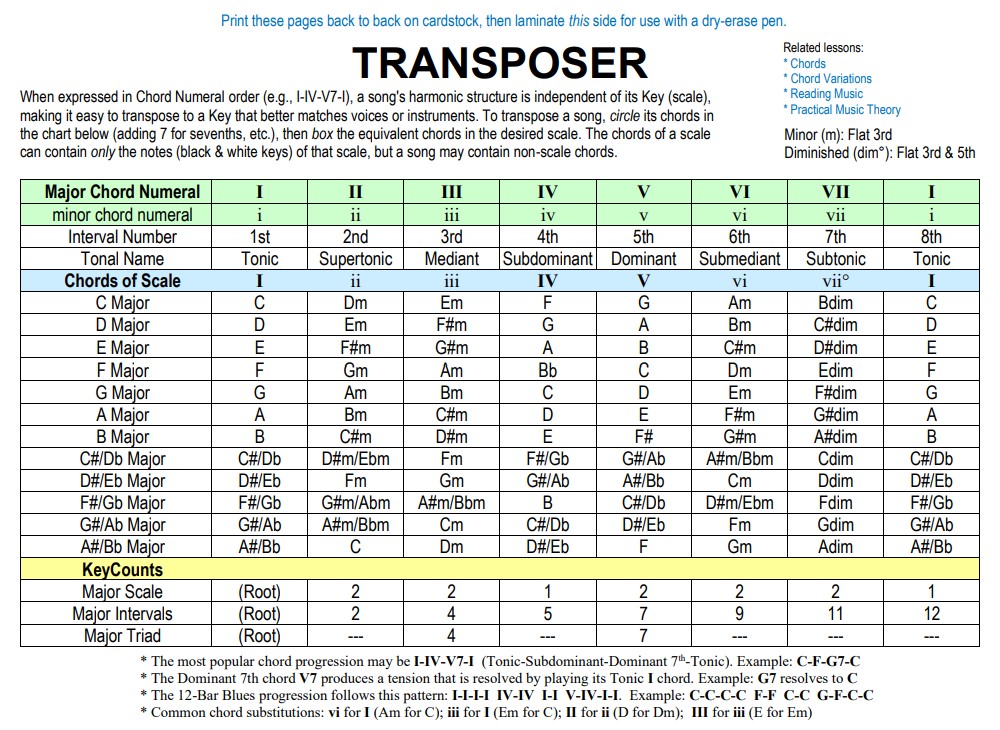 2 pages |
|
|
88 & 5th Chart Print and laminate (see video above) this chart for use with a dry-erase pen to build scales, intervals, and chords, develop chord progressions, and transpose songs. |
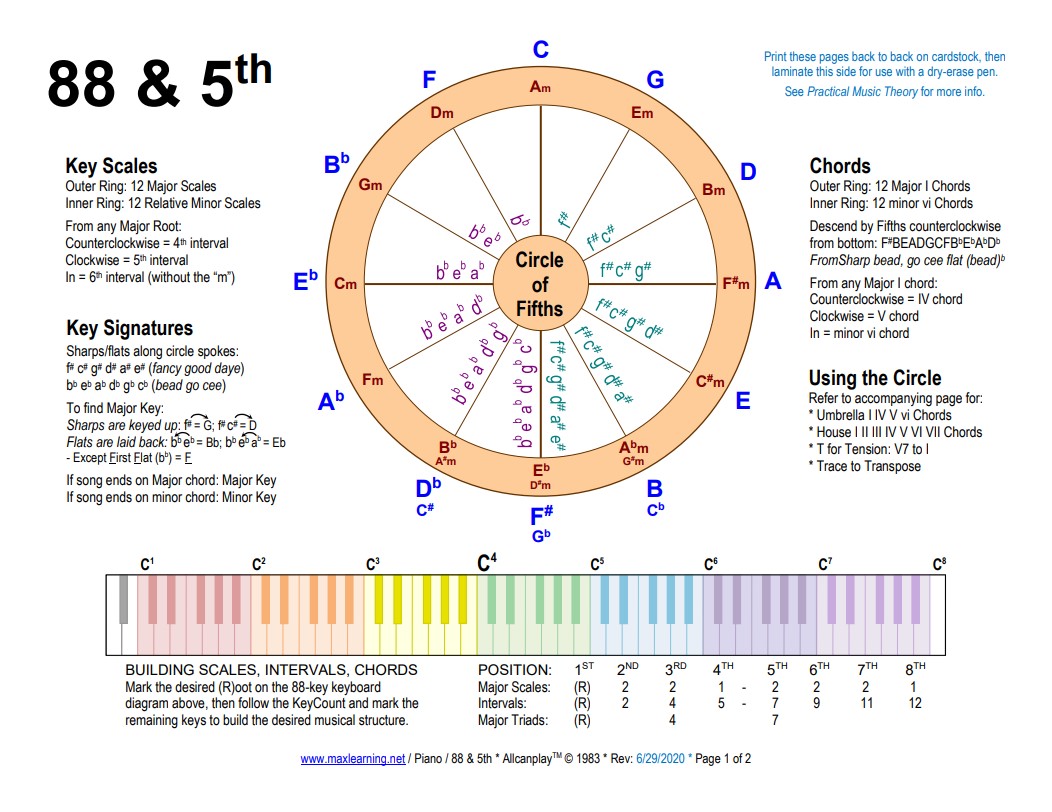 2 pages |
|
|
Improvisation Techniques Enhance or modify the songs you already know by transposing keys and chords, shifting octaves, adding intervals, inserting grace notes, crushes, and mordents, styling and substituting chords, and experimenting with arpeggio patterns. |
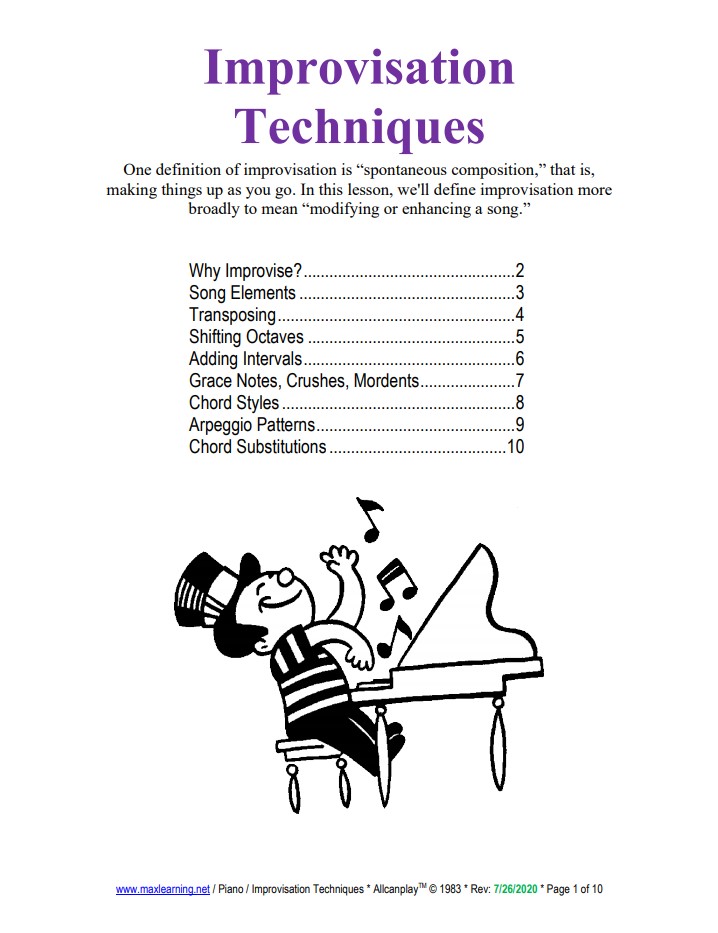 10 pages |
|
|
CLAIR DE LUNE This beautiful classic composed by Claude Debussy in 1890 is technically challenging, spanning 6 octaves over 72 measures and 2 Keys. It takes ~5 minutes to play, but if you love the song, it's worth the effort. |
Pages 1-3 4-7 Moura Lympany audio 5:02 min |
|
|
Blank Keyboard Songsheets |
||
|
RAINBOW
KEYBOARD SONGSHEETS Use a song's Hi/Lo notes to determine the appropriate keyboard sheets to print. 2½ OCTAVES Yellow C3 to Blue E5 3 columns / 68 [72] keyboards 4 OCTAVES Orange C2 to Blue B5 2 columns / 45 [48] keyboards 88 KEYS Low A0 to High C8 1 column / 22 [24] keyboards |
2½ octaves 4 octaves For songs that occasionally exceed the octave span, use the "+/- Octaves" symbol notation (See Allcanplay Symbols). |
88 keys To minimize pages for wide-span songs, electronically snip or physically print, cut, and paste the needed octave spans together on a page (See Clair de Lune). |
|
Vintage Songs |
||
|
Allcanplay notation has evolved since its official introduction in 1983
by a small corporation I formed called ServNet. * Instead of Rainbow shading with C1-C7 numbered octaves, I used a single color (red, blue, or gray) on either side of an unshaded Middle C octave and marked Middle C4 with a wedge. * Instead of finger letters (LRMPT / tpmrl), I used X's for the left hand and Dots for the right hand. If desired, see the "Fingering" lesson and pencil in your preferred fingering above the X's and Dots. * Paralleling standard music notation, instead of Ties ending in a dash, I ended them in another X or Dot. Be sure to play only the first X or Dot and let go on the second. * I scanned then reduced these songs from their original 9 x 12" music book format to 8.5 x 11" letter size so you can print them on a standard printer or more easily view them on a tablet computer at your piano. |
GETTING STARTED (5) * Row, Row, Row Your Boat * Oh Dear, What Can The Matter Be? * Did You Ever See A Lassie? * For He's a Jolly Good Fellow! * Auld Lang Syne CHRISTMAS FAVORITES (12) * We Wish You A Merry Christmas * Joy To The World * O Christmas Tree * Away In A Manger * Silent Night * The First Noel * Jingle Bells * Angels We Have Heard On High * Oh Little Town Of Bethlehem * O Come All Ye Faithful * God Rest Ye Merry, Gentlemen * Deck The Halls EVERYONE'S FAVORITES (8) * Swing Low Sweet Chariot * The Sidewalks of New York * When Johnny Comes Marching Home * She'll Be Comin' 'Round The Mountain * Greensleeves * While Strolling Through The Park One Day * He's Got The Whole World In His Hands * My Country 'Tis Of Thee |
ALL-TIME FAVORITES (9) * On Top Of Old Smoky * Kum Ba Ya * Home On The Range * House Of The Rising Sun * Amazing Grace * Drink To Me Only With Thine Eyes * Michael (Row The Boat Ashore) * Oh My Darling, Clementine * Battle Hymn Of The Republic JOHN DENVER (6) * Take Me Home, Country Roads * Annie's Song * Sunshine On My Shoulders * Leaving On A Jet Plane * Fly Away * Rocky Mountain High LENNON-McCARTNEY
(6) KENNY ROGERS (6) |
|
Copyrighted Songs |
||
|
BREAKING UP IS HARD TO DO (slow version) This is the song that inspired me to create Allcanplay! Neil Sedaka recorded the fast version in 1962 followed by the slow version in 1975. Both were hits! With sophisticated chords and intricate timing spanning 6 octaves over 45 measures, it greatly stretched my sight-reading ability when it shifted keys from G (1 sharp) to Ab (4 flats). But I really wanted to play it and Allcanplay was born! |
||
|
SUCCESSION THEME (HBO) Succession is a satirical HBO (now MAX) television series about 3 siblings fighting for control of their ailing father's media empire. The award-winning theme was composed by Nicholas Britell in 2018. Originally 50 measures, I've trimmed it down to 22 measures emphasizing the driving, repetitive main theme, which presents two challenges: Spanning 7 octaves, it's tough to see both hands at the same time; and the speed at which it's supposed to be played makes accuracy difficult. It must be practiced slowly without error before gradually speeding up. If you're a fan, it's satisfying to play at reduced speed. |
||
|
User Contributions |
||
|
If you convert a favorite song from the
public domain (pre-1926) to Allcanplay, please scan and/or save it in .pdf format then email
it to mike.weinberg1952@gmail.com.
Follow the steps in the "Converting Songs to Allcanplay" lesson using small x's for the left hand and tiny dots for the right hand as placeholders. Then if desired, follow the "Fingering" Lesson to pencil in finger letters. Trace over the left hand letters in black ink and the right hand letters in red ink. |
Song - Converted By Song: Converted by: Song: Converted by: |
|
|
Evolution of Allcanplay |
||
| Why are keyboard diagrams stacked in columns instead of left to right? Why is "and" included with each musical beat? Why are finger letters used instead of numbers? How do arpeggio arrows and rainbow shading improve accuracy while saving space? What is the future of Allcanplay? | ||
|
Allcanplay on TV! |
||
|
Channel 8 News |
Channel 10 News |
|
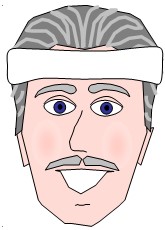 Hi, my name is A.C. Player,
and I'll be your guide to making beautiful music on the piano! To get you
playing songs more quickly, we'll use my AllcanplayTM play-by-picture system,
which shows you exactly which keys to
press
without
reading music! Then we'll cover chords, how to play by ear,
and how to
read music. You'll learn to play simpler songs
from sheet music and convert harder
songs to Allcanplay.
After some practical music theory, I'll show you improvisation
techniques that will enliven any song.
We'll have loads of musical fun while keeping our
fingers limber and our brains
stretched!
Hi, my name is A.C. Player,
and I'll be your guide to making beautiful music on the piano! To get you
playing songs more quickly, we'll use my AllcanplayTM play-by-picture system,
which shows you exactly which keys to
press
without
reading music! Then we'll cover chords, how to play by ear,
and how to
read music. You'll learn to play simpler songs
from sheet music and convert harder
songs to Allcanplay.
After some practical music theory, I'll show you improvisation
techniques that will enliven any song.
We'll have loads of musical fun while keeping our
fingers limber and our brains
stretched! 